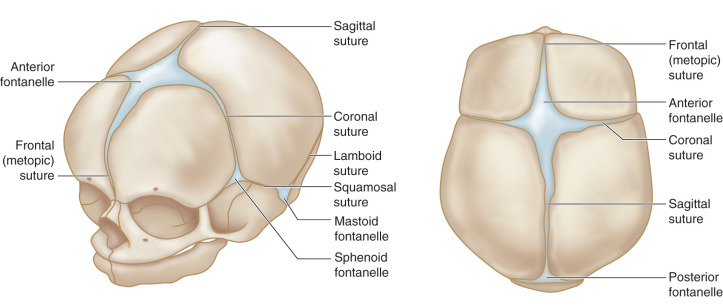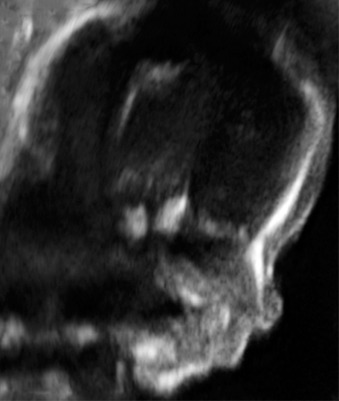Abstract
The fetal cranium is composed of bony plates that are joined together by areas of dense fibrous tissue termed cranial sutures (sagittal, coronal, lambdoid, and metopic). Usually, these sutures do not close before 18 to 24 months of life. Premature suture closure, also termed craniosynostosis, results in bony deformation of the skull and may have serious implications for skull growth, including subsequent normal brain development. Craniosynostosis can occur primarily or secondarily. Primary craniosynostosis is divided further into syndromic and nonsyndromic. More than 150 syndromes involving craniosynostosis have been described. On ultrasound (US), an axial image showing an abnormal cranial contour is usually the first sign of craniosynostosis. Three-dimensional or four-dimensional US can be useful for delineation of suture involvement and evaluation of the fetal facies, hands, and feet for any dysmorphisms, which can provide clues to underlying disorders.
Keywords
craniosynostosis, FGFR2 , FGFR3 , Apert syndrome
Introduction
The development of the fetal skull is a complex process involving intramembranous and endochondral ossification. The fetal cranium comprises bony plates that are joined together by areas of dense fibrous tissue termed cranial sutures, comprised of the sagittal, coronal, lambdoid, and metopic sutures ( Fig. 62.1 ). The membranous sutures allow for expansion of the calvaria to accommodate rapid human brain growth prenatally and postnatally. The sutures and fontanelles, larger membranous areas where suture lines converge, are also critical to enabling the normal process of cranial molding essential to the process of vaginal birth. Although some of these sutures begin to close in the first year of life, most do not begin to close significantly before 18–24 months of life, and suture closure is not complete until adulthood. Premature closure of the sutures, also termed craniosynostosis, results in bony deformation of the skull and may have serious implications for skull growth, which in many cases affect normal brain development.

Craniosynostosis can occur primarily or secondarily. Primary craniosynostosis can be either syndromic or nonsyndromic (isolated craniosynostosis with no evidence of a genetic syndrome). Craniosynostosis has been described as a feature of more than 150 genetic syndromes. The goal of prenatal detection of craniosynostosis is to enable prenatal diagnosis of the syndromic cases and to enable awareness of the potential perinatal complications of prenatal onset craniosynostosis that includes increased incidence of malpresentation and development of secondary complications such as hydrocephalus.
Disorder
Definition
Craniosynostosis refers to the premature closure of one or more cranial sutures, which may occur during the prenatal period, early infancy, or childhood. It is a finding, not a diagnosis, and may be isolated or may be associated with genetic syndromes associated with serious sequelae.
Prevalence and Epidemiology
The birth prevalence of craniosynostosis (primary and secondary) is estimated to be 4 : 10,000 live births. Approximately 75% of cases of craniosynostosis are isolated, whereas additional anomalies are found in about 25% of cases, highly suggestive of a genetic syndrome. More than 150 genetic syndromes are associated with primary craniosynostosis including the more common craniosynostoses: Crouzon, Apert, Pfeiffer, Saethre-Chotzen, and Muenke syndromes. Each of these diseases are rare and usually the result of a de novo mutation because they are autosomal dominant or sporadic in inheritance. Exceptions occur, as seen in cases of Saethre-Chotzen syndrome, where a higher incidence of cases may be familial. Other structural abnormalities are detected in 5% to 10% of primary craniosynostosis cases without a precise identifiable genetic syndrome, and primarily involving central nervous system, cardiovascular, or musculoskeletal anomalies. Similar to other autosomal dominant disorders, advanced paternal age has been associated with de novo occurring mutations in fibroblast growth factor receptor 2 (FGFR2) that cause Apert, Crouzon, and Pfeiffer syndrome.
Secondary craniosynostosis can occur, owing to deformational compressive forces, maternal or neonatal metabolic derangements (such as hypophosphatasia syndrome [ Chapter 51 ]), or teratogenic influences. Multiple gestation, hyperthyroidism, hypercalcemia, living at higher altitudes, tobacco use, and valproate therapy all have been implicated as prenatal risk factors in the development of isolated secondary craniosynostosis.
In cases of isolated, nonsyndromic craniosynostosis, the sagittal suture is most commonly involved (39%–57%), followed by unilateral or bilateral coronal sutures (17%–29%), metopic suture (10%–22%), lambdoid suture (5%–17%), and, rarely, multiple sutures (<10%) (see Fig. 62.1 ). There is an approximate 3 : 1 male predominance for isolated sagittal synostosis and some studies have suggested there is also a male predominance for metopic synostosis. There is a slight female predominance for isolated coronal synostosis.
Etiology, Pathophysiology, and Embryology
The mechanisms underlying nonsyndromic premature cranial suture fusion remains poorly understood, but inroads have been made in our understanding of the molecular mechanisms. Starting with identification in 1993 of an MSX2 mutation in a family with craniosynostosis, there have been more than 50 genes associated with craniosynostosis. In cases of syndromic craniosynostosis, commonly involved genes include FGFR1, FGFR2, and FGFR3 . Heterozygosity for mutations in the gene encoding FGFR2 are the most common cause of craniosynostosis syndromes. Heterozygosity for mutation in the gene encoding FGFR3 produces Muenke syndrome as well as other disorders in which craniosynostosis can occur (e.g., thanatophoric dysplasia type II and Crouzon syndrome with acanthosis nigricans). Mutations in the gene that encodes FGFR2 produce Apert, Crouzon, and Pfeiffer syndromes. The mutations in FGFRs associated with craniosynostosis syndromes result in accentuated ligand binding and increased receptor activation. Among craniosynostosis syndromes not related to FGFRs 1,2, and 3 , Saethre-Chotzen syndrome results from heterozygosity for mutations in the transcription factor gene TWIST1, as well as TCF12, one of its binding partners. One of the interesting findings in syndromic forms of craniosynostosis syndrome is that the genetic mutations can have variable degrees of penetrance.
Manifestations of Disease
Clinical Presentation
Craniosynostosis results in predictable skull deformation based on the sutures involved. Bony growth is greatly inhibited in the plane perpendicular to the synostotic suture and proceeds parallel to the involved suture in a compensatory, exaggerated fashion. Sagittal synostosis leads to bitemporal narrowing with frontal and occipital bossing (dolichocephaly or scaphocephaly). Bilateral coronal synostosis results in a broad, tall skull (brachycephaly). Lambdoid synostosis can result in brachycephaly similar to that seen with coronal synostosis, although lambdoidal involvement affects the posterior skull predominantly. Unilateral coronal or lambdoidal synostosis results in an asymmetric skull shape (plagiocephaly) and may be associated with facial asymmetry. When multiple sutures are affected, the skull takes on a distinctive cloverleaf appearance, also known as kleeblattschädel , commonly seen in thanatophoric dysplasia.
Although most cases of craniosynostosis are diagnosed in infancy or early childhood, suspicious ultrasound (US) findings may lead to prenatal diagnosis, and craniosynostosis often begins in the third trimester. Fetuses with early-onset craniosynostosis may present with abnormal cranial contour in the second trimester and, in certain craniosynostosis syndromes, with characteristic malformations of the hands and feet. Identification of an abnormal cranial contour should prompt a more detailed evaluation of the fetal extremities to detect findings suggestive of the most common craniosynostosis syndromes, Apert and Pfeiffer syndromes. Fetuses with Apert syndrome have irregular craniosynostosis, causing a high, large forehead and midface hypoplasia ( Figs. 62.2 and 62.3 ), and bony syndactyly of the hands and feet is seen in most cases, often with a characteristic mitten hand appearance resulting from bony syndactyly of the second through fourth digits ( Fig. 62.4 ). In Pfeiffer syndrome, varying degrees of brachydactyly are seen, often in association with a characteristically broad, medially deviated thumb or hallux. In addition, central nervous system anomalies, including agenesis of the corpus callosum and ventriculomegaly, have been seen in conjunction with both syndromes.











